History as Cinema
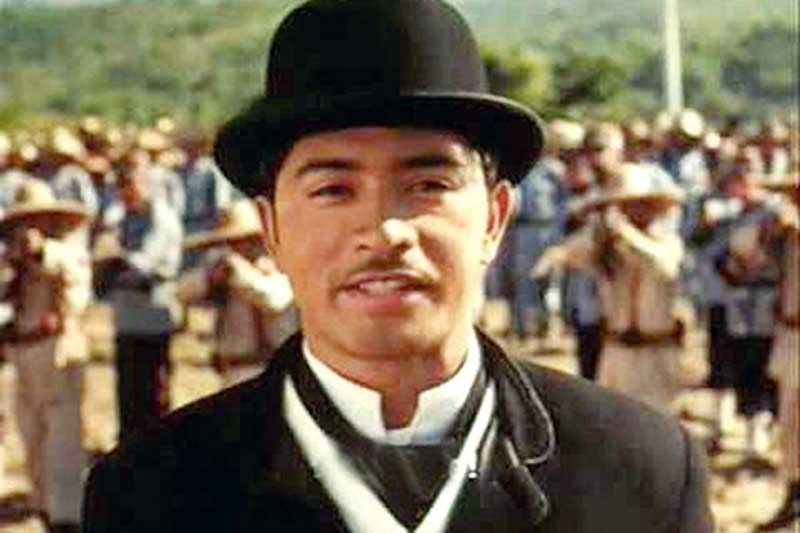
Of this genre, the most difficult subclass to execute is the historical film. For not only does one need to replicate — in set and in props — the period in which the film is set (decades or even centuries ago), but the life of the subject is not capable of direct research.
MANILA, Philippines — If life imitates art, as Oscar Wilde once said, then the film biography is quite the obverse: It is art imitating life.
Of this genre, the most difficult subclass to execute is the historical film. For not only does one need to replicate — in set and in props — the period in which the film is set (decades or even centuries ago), but the life of the subject is not capable of direct research. The film writer, often with the aid of a historian, must pore over copious amounts of old literature. And if one has to resort to secondary sources, then one must contend with history books in which is embedded the author’s particular interpretation of people and events; in some cases, colored with specific biases.
It is in this light that four significant local historical films must be seen: Jose Rizal (1998, GMA Films), El Presidente (2012, Scenema Concepts/Viva Films), Heneral Luna (2015, Articulo Uno) and Sakay (1993, Alpha Omega Productions). I list them not in order of release, but of the chronology of events depicted in them in relation to the Philippine Revolution of 1898: Rizal as the pre-revolutionary spark; Aguinaldo, the Revolutionary leader; Luna, his best general cut down too soon due to internecine strife; and Sakay, one of the last holdouts after the First Philippine Republic had fallen and the Revolution all but failed.
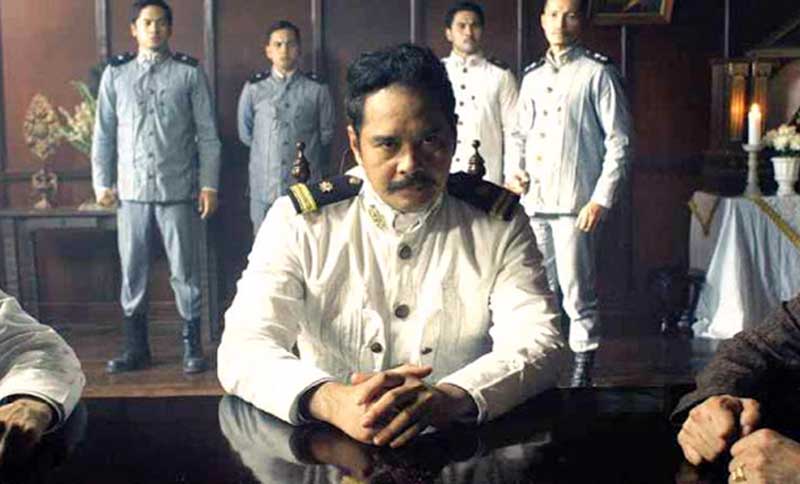
John Arcilla in Heneral Luna.
Of the four, Marilou Diaz-Abaya’s Jose Rizal is the most grandiose; from all indications, GMA 7 wanted it to serve as their big and bold proclamation that they were ready to do battle with the Big Boys. With the redoubtable Ricky Lee penning the screenplay and with Cesar Montano (then at his peak in popularity and thespic skills) in the lead, it had a budget of P80M, gargantuan for 1998. It could thus afford such exacting attention to detail as minting replica Spanish-era coinage, authentic costumes, then cutting-edge computer graphics and a Dolby Surround soundtrack, a first for a Filipino movie.
The movie itself is spectacular. Opening with a scene showing an obese priest having sexual congress with a peasant lass, it early on established its iconoclastic slant. It then followed with a sweeping vista of what it was like in Rizal’s Philippines, a colonial quasi-theocracy where even the brightest indio’s upward mobility was limited by the color of his skin and his ethnicity. The narrative, while engaging, suffered from the curse of familiarity: Blame the mandatory teaching of Rizal’s life and writings in college for that. Perhaps mindful of this, the filmmaker tried to inject novelty not only by employing moderately-stylized visuals, but by suffusing the work with some non-linear storytelling. Towards the end, though, the viewer is saddled with naught but a perfunctory parade of the best-known aspects of the hero’s life: His trial and death.
Diaz-Abaya, armed with abundant talent and resources, naturally delivers what is expected of a director of her caliber: Jose Rizal is tight, well-made, well-acted and a feast for the eyes. The briefness of the subject’s life, however, prevents it from being an epic, notwithstanding the inclusion of the context of colonial society which frames the film. What it also lacks is a sense of enlightenment. The movie offers no new insights, no profound commentaries, nothing that an ardent Rizalista — or even a college student who took Rizal course — would not already know. The veneer is shiny and glamorous, but it has little by way of pith.
If it is serious epic you want, El Presidente has it in spades. Rivalling Jose Rizal in financial heft (budget: P120M), if not in the performance of its lead, the scope of the movie spanned generations, because Aguinaldo lived to be 94. Watching the movie, you can see where the budget went: Authentic copies of weapons used by both sides during the Revolution and the Philippine-American War, period costumes galore, elaborate sets, excellent special effect including digital graphics, and painstakingly made-props (including a restored version of Aguinaldo’s car). Also, the battle scenes, choreographed with complexity with hundreds of extras, are some of the best ever seen in Filipino movies. As a panoramic period piece, it is thoroughly satisfying.
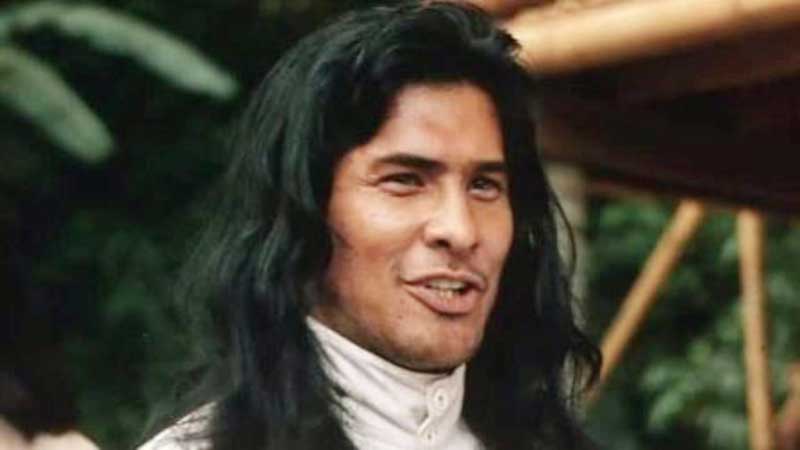
Julio Diaz in Sakay.
The movie, however, is held back mainly by the limitations of E.R. Ejercito playing Aguinaldo. To be sure, he strives mightily, but he simply does not have the emotional depth and the wellspring of experiences that would have made a profound reading of such a complex man as the first president of the Republic. Aguinaldo was a creature of his time and upbringing, patriarchal and parochial. He had what it took to successfully battle the forces of a European power in decline, but was ill-equipped to cope with the military of a surging nation starting to build its own overseas empire with new-fangled weapons and strategies. Ejercito was partly able to bring the inherent contradictions of Aguinaldo to the fore, but he principally concentrated on the man’s strength, portraying him as a an ubermensch ultimately betrayed by a fractious army and the weakness of the leadership of those around him. In so doing, he neglected the other facets of the general’s personality. His portrayal, though, of an older Aguinaldo increasingly saddened by his progressive irrelevance in a post-World War II Philippines, where the revolution as a living memory was fast-disappearing, is effectively poignant.
More forceful is John Arcilla’s depiction of the controversial Heneral Luna in the movie of the same title. A tad too forcefully, if you’d ask me, bordering on over-the-top. But then again, some historians would argue that based on eyewitness accounts, that was how the real Luna was. Arcilla’s general cursed, and ranted, and raved, and gesticulated wildly when in anger. He was rash, reckless, contemptuous both of authority and his subordinates, always convinced he was right. This proved to be Luna’s undoing both in the picture and in real life. With a not-too-modest budget of P80M, Jerrold Tarog gives us a movie that is meticulously-crafted and engaging. He was also wise to populate the film with denizens from the local theater industry as well as reliable movie veterans; the over-all level of acting is noticeably superior to the last two movies mentioned. The dialogue is also replete with quotable quotes (“Negosyo o kalayaan? Bayan o sarili?”; “Para kayong mga birhen na naniniwala sa pag-ibig ng isang puta!”), although whether or not the real General Luna actually said them is open to serious doubt. Ultimately, however, the screenplay comes off as preachy and stilted, detracting from the film’s realism, which the producers sought to achieve painstakingly by the use of good costume, props, set and locations.
In contrast with El Presidente, which was Aguinaldo’s life in filter (since it was based largely on his own memoirs), Heneral Luna paints the revolutionary president in less flattering colors. The Aguinaldo in Heneral Luna was despotic yet indecisive, out of his depth and unable to fathom how dire the situation of the First Republic was in, easily manipulated by his closest advisers who were mostly confined to Caviteños. It also depicted other leaders of the revolution as insubordinate to Luna (who was then head of the Army) and derisive of his fixation with strict military discipline and the chain of command. The result was an armed force imbued with a strong will to fight but in disarray, easily isolated into ineffective pieces by the enemy and handily defeated by inferior numbers.
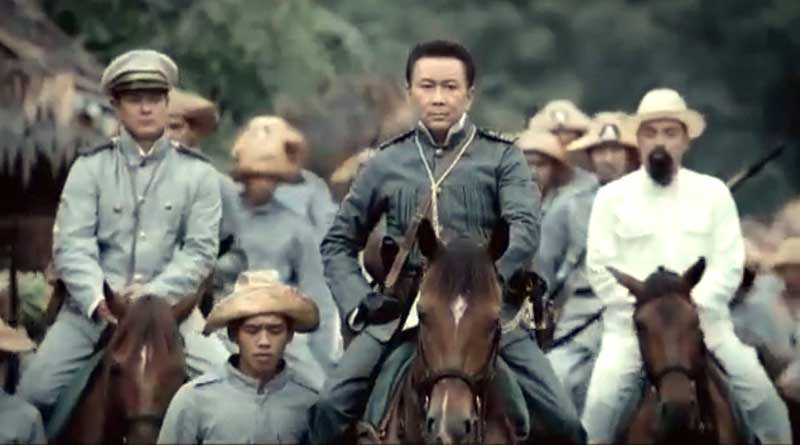
E.R. Ejercito in El Presidente.
Of the four, Raymond Red’s Sakay, is the “poor relation,” so to speak. Made on a budget hardly sufficient for a 30-second television commercial (I exaggerate, of course, but it was low-budget), Red must be credited for doing so much with so little. Like Heneral Luna, it was inhabited by theater stalwarts like Pen Medina (as Col. De Vega), Ray Ventura (as Gen. Felizardo) and John Arcilla (as Gen. Villafuerte). And of course, Julio Diaz in the title role. Essaying the role of commanders of the ragtag remnants of a once-proud Army, it was big in the acting department. It was also the most straightforward and coherent in its narrative arc. As a footnote, the movie also featured the legendary Leopoldo Salcedo, the “Great Profile,” in his last movie role as Sakay’s father, who appeared to him as a ghost to give him fatherly advice and encouragement before he embarked on his quest to carry on the struggle. The other known “star” in the movie was Tetchie Agbayani, as Sakay’s love interest; she was the only one who turned in a so-so performance (pun unintended).
With such a tight budget, Red was resourceful — nay, genius! — in attempting to make his film look like it had more. Using every trick in the movie-making book, he intercut, repurposed extras, used multiple angles, made do with existing structures as sets, and utilized stage costumes. The effort is well-rewarded, with the paucity in resources evident only in the battle scenes, where there can be no substitute for expensive special effects and equipage.
Diaz gave a multi-layered and profound performance as the cochero and zarzuelista-turned-revolutionary leader styling himself as the Presidente ng Republika ng Katagalugan, vainly trying to re-establish, with scant weapons, men and resources, the republic so majestically founded by Filipino patriots with Aguinaldo at its helm, and so cruelly nipped in the bud by the Americans. Considered bandits by the new colonial power, the stragglers bravely fought on, fueled by a sense of legitimacy and emboldened in battle by a misplaced reliance on amulets and ancient Latin talismans that supposedly made them impervious to bullets. In the end, their cause was crushed, not solely by the superior firepower of the United States Army, but by the local elite who collaborated with the foreign powers-that-be to give up the remainders of a revolution that was generally believed to be lost.
In fine, for all the variance among the four movies in budget, style and acting, it is that thesis — that the revolution spawned by enlightened nationalists was betrayed by an elite unwilling and unable to suffer the pains and sacrifices that a nationalist revolution entails — that runs through them as a common thread. From the wealthy mestizo peninsulares lobbying for assimilation into rather than independence from Spain in Jose Rizal, to Judge Felipe Buencamino who Gen. Antonio Luna bitch-slapped in Aguinaldo’s presence during a Cabinet meeting for proposing an entente with the Americans in Heneral Luna, on to lawyer Pedro Paterno continually urging Aguinaldo to yield to American rule and after the president’s capture becoming a Yankee lackey in El Presidente, and finally Dr. Dominador Gomez leading Macario Sakay into a trap that eventually led to his hanging, it would appear that the landscape of our revolution is peopled by traitors who chose their own narrow interests over the country’s independence.
So, as art imitates life, these four movies — Jose Rizal, El Presidente, Heneral Luna and Sakay — cannot but be all tragedies. For they can only darkly echo our own poignant bid for liberty then, as we beheld our newborn republic dying in the cradle, after so much blood had been shed for its birth.
- Latest
- Trending

























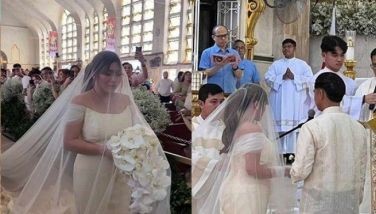

 Exclusive
Exclusive




